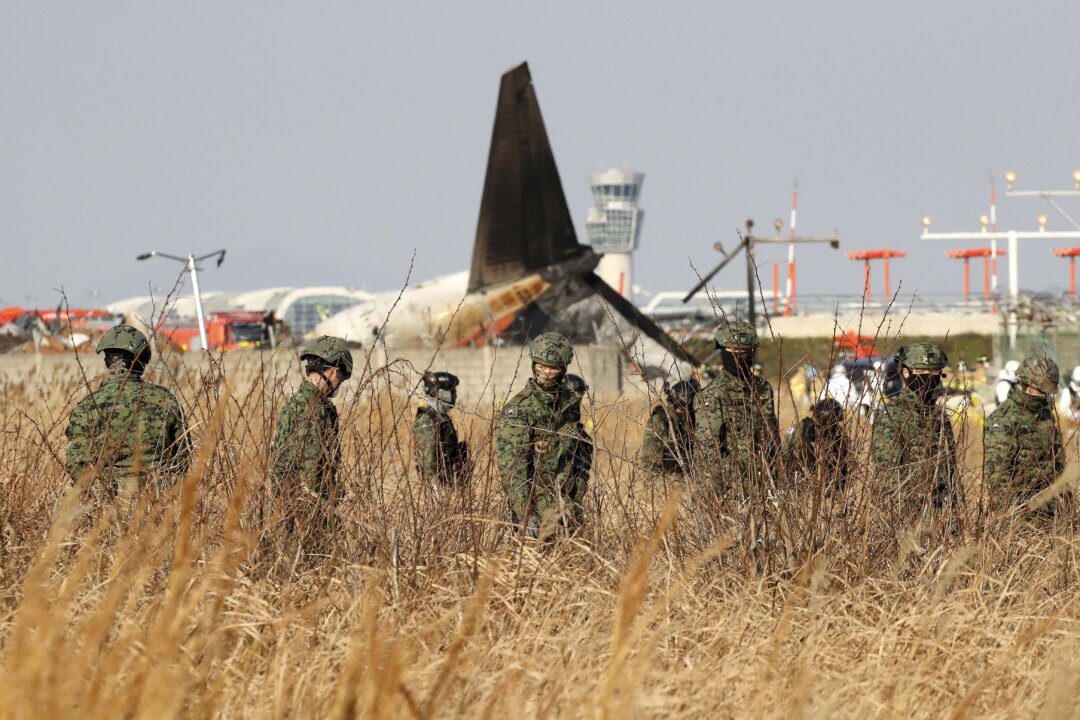MUAN COUNTY, South Korea—South Korea’s acting President Choi Sang-mok on Monday ordered an emergency safety inspection of the country’s entire airline operation system as investigators worked to identify victims and find out what caused deadliest air disaster in the country.
All 175 passengers and four of the six crew were killed when a Jeju Air Boeing 737-800 belly-landed and skidded off the end of the runway at Muan International Airport, erupting in a fireball as it slammed into a wall. Two crew members were pulled out alive.
The top priority for now is identifying the victims, supporting their families and treating the two survivors, Choi told a disaster management meeting in Seoul.
“Even before the final results are out, we ask that officials transparently disclose the accident investigation process and promptly inform the bereaved families,” he said.
“As soon as the accident recovery is conducted, the transport ministry is requested to conduct an emergency safety inspection of the entire aircraft operation system to prevent recurrence of aircraft accidents,” he said.
The transport ministry said authorities were considering whether to conduct a special inspection of all 101 Boeing 737-800 aircraft operated by South Korean airliners.
Jeju Air flight 7C2216, arriving from the Thai capital Bangkok with 175 passengers and six crew on board, was trying to land shortly after 9 a.m. on Sunday at the airport in the south of the country.
Investigators are examining bird strikes and weather conditions as possible factors in the crash, fire officials have said. Experts say many questions remain, including why the plane, powered by two CFM 56-7B26 engines, appeared to be travelling so fast and why its landing gear did not appear to be down when it skidded down the runway and into a wall.
CFM International is a joint venture between GE Aerospace and France’s Safran.
On Monday, transport ministry officials said as the pilots made a scheduled approach they told air traffic control the aircraft had suffered a bird strike, shortly after the control tower gave them a warning birds were spotted in the vicinity.
The pilots then declared mayday and signaled their intention to go around shortly before the aircraft came down on the runway in a belly landing and crashed into a structure at the end of the runway.
Officials are investigating what role the localizer antenna, located at the end of the runway to help in landing, played in the crash, including the embankment on which it was standing, transport ministry officials told a media briefing.
The crash killed mostly local residents who were returning from holidays in Thailand, while two Thai nationals also died.
On Monday morning, investigators were trying to identify some of the last remaining victims, as anguished families waited inside the Muan airport terminal.
Park Han-shin, who lost his brother in the crash, said he was told by authorities that his brother had been identified but has not been able to see his body.
Park called on other victims’ families to unite in responding to the disaster and recovery efforts, citing a 2014 ferry sinking that killed more than 300 people. Prolonged efforts to identify the victims and cause of the sinking followed that disaster.
Emergency workers were sifting through wreckage that was nearly completely destroyed when the aircraft was engulfed in an explosion of flames and debris at the regional airport near the country’s winding western coastline.
Transportation ministry officials said the jet’s flight data recorder was recovered but appeared to have sustained some damage on the outside and it was not yet clear whether the data was sufficiently intact to be analyzed.
The Muan airport remains closed through Wednesday but the rest of the country’s international and regional airports including the main Incheon International Airport were operating as scheduled.
Shares of Jeju Air hit their lowest level on record on Monday, trading as much as 15.7 percent lower.
Under global aviation rules, South Korea will lead a civil investigation into the crash and automatically involve the National Transportation Safety Board (NTSB) in the United States where the plane was designed and built.
The NTSB said it was leading a team of U.S. investigators to help South Korea’s aviation authority. Boeing and the Federal Aviation Administration were also taking part.
Choi, who was overseeing recovery efforts and the investigation, became acting leader just three days ago after the country’s president and prime minister were impeached over the imposition of a short-lived martial law.

